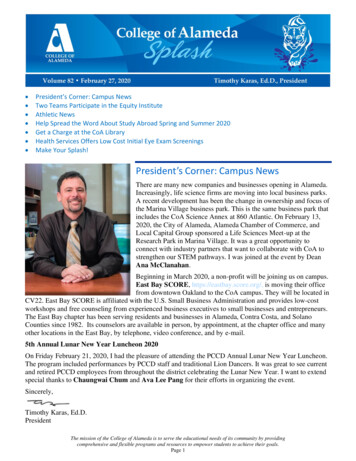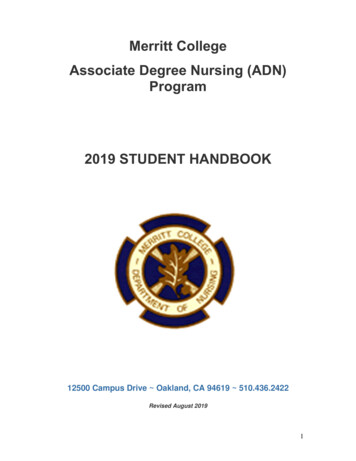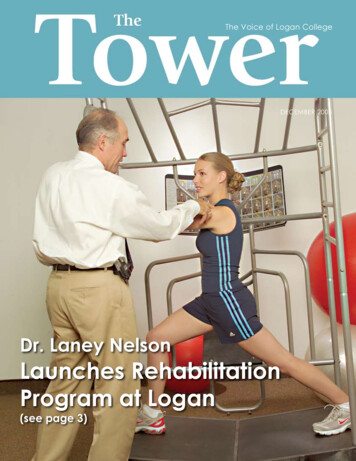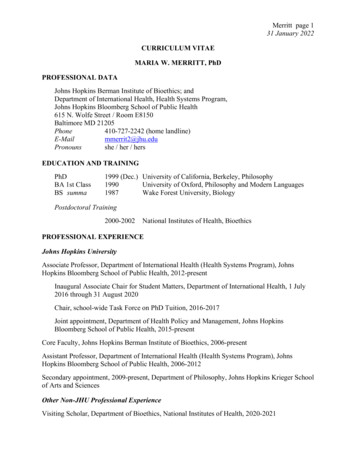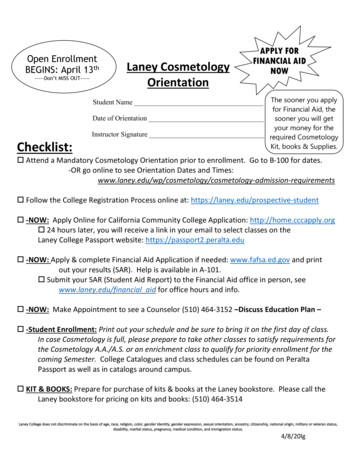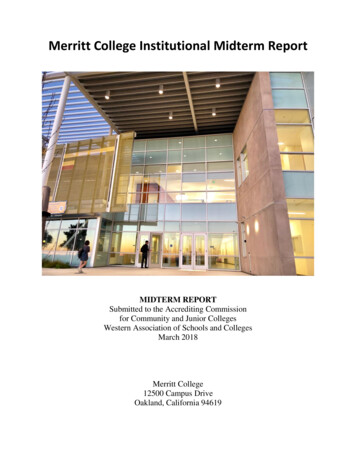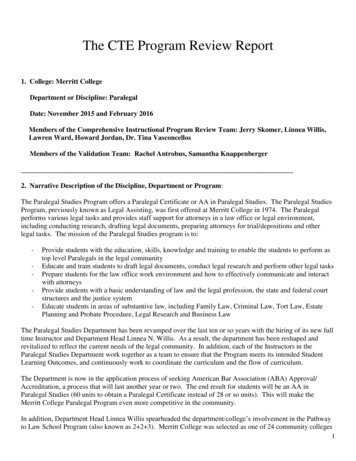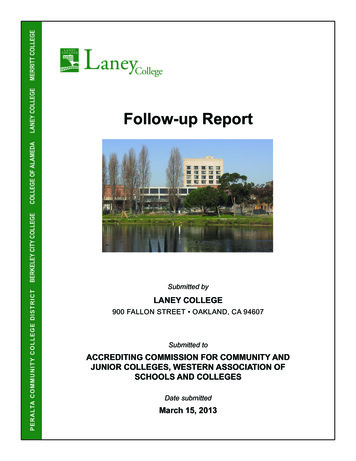
Transcription
MERRITT COLLEGECollegeFollow-up ReportPERALTA COMMUNITY COLLEGE DISTRICTBERKELEY CITY COLLEGECOLLEGE OF ALAMEDALANEY COLLEGELaneySubmitted byLANEY COLLEGE900 FALLON STREET OAKLAND, CA 94607Submitted toACCREDITING COMMISSION FOR COMMUNITY ANDJUNIOR COLLEGES, WESTERN ASSOCIATION OFSCHOOLS AND COLLEGESDate submittedMarch 15, 2013
Table of ContentsStatement on Report Preparation5Commission Recommendation 2: Audit Findings Corrective Action Matrix6Commission Recommendation 3: Fiscal Stability13Commission Recommendation 4: Board Policy vs. Administrative Procedures19Governing Board ReviewCommission Recommendation 5: Financial Decisions & Quality Educational l ApproachSummary of the District Financial Decisions and the College BudgetDistrict Financial Decisions28Analysis of the Impacts of Financial Decisions on StaffingAnalysis of the Impact on FacultyAnalysis of the Impact on Classified StaffAnalysis of the Impact on Administrative Staff33Analysis of the Impact of Financial Decisions on the Quality of EducationalPrograms and Services46Overview of the Budget Context – Prior to & After Budget ReductionsAnalysis of the Impact of Budget Reductions on Academic Affairs (Instruction)Impact on Overall Program ViabilityCourse OfferingsAcademic IntegrityCareer and Technical Education ProgramsGeneral and Transfer EducationSustaining Quality Academic Affairs ProgramsAnalysis of the Impact of Budget Reductions on Student Affairs (Student Support Services)Student Affairs Viability, Quality and IntegritySustaining Quality Student Affairs ProgramsEvaluation of the Impact of Financial Decisions on Student Success82Measuring Student SuccessProgress & AchievementSuccess & Retention RatesDegree & Certificate CompletionCSU & UC Transfers3
Plan for Ensuring Quality Educational Programs and ServicesThe College’s Effort to Deal with the Impact of Recent Fiscal Changes93Laney College MissionLaney College Financial Planning PrinciplesLaney College Strengthened Structures & PracticesEnsure Strategic and Managerial LeadershipContinued Collaboration and AdvocacyGrants, Contracts and DonationsAnalysis of the Impact of Fiscal Changes on District Provided ServicesDistrict/College Solutions102Evidence of Meeting Eligibility Requirements 5 & 17104Financial Resources DocumentedFederal, State and Local GrantsQuality PrioritizedIntegrated District and College Planning – Aligned PrioritiesEnsuring Administrative Quality – Meeting ER 5Ensuring Staff J.K.L.Laney College Accreditation TaskforceLaney College Council MembersAcademic and Student Affairs CouncilLaney College Alternative Sources of Funding, 2012-13Listing of Contract Faculty Vacancies by DepartmentListing of Classified Staff VacanciesListing of Academic Administrators Before and After Fiscal ImpactJob description of the Senior College Information Systems AnalystLaney College ESL – Assessment as an Impetus for ChangeJob description of the Department Chairperson (tentative agreement)Laney College 2012-13 Goals & BenchmarksLaney College 2009-2012 Awards by subjectEvidence1444
Statement of Report PreparationLaney College began the preparation of this Follow-Up Report in August of 2012 in response to arequest from the ACCJC concerning Recommendations 2, 3, 4 and 5. At the summer 2012 retreat, thefaculty, classified staff, students and administrators chose sound completion and submittal of this Reportas one of the College’s 2012-13 goals. Before flex day in-service meetings began at the start of the fallsemester, employees received a special letter at home emphasizing the importance of the Follow-UpReport. At the District-wide Professional Development Day in August, the Peralta chancellor addressedthe importance of the upcoming accreditation visit and the follow-up reports that would be prepared bythe colleges. The following day, President Webb echoed Chancellor Ortiz’s emphasis on the importanceof the upcoming College accreditation report and visit in March of 2013. This was also conveyed in theOffice of the President’s newsletter, and remained a central theme at administrative leadership andshared governance meetings throughout the fall of 2012.The Laney College leadership prepared an outline and timeline for addressing the Commission’s requestfor further analysis of eligibility requirements #5 and #17, and Standard III.D. The outline’s major areasof focus included: the quality of Laney College’s educational programs and services; the evaluation ofthe impact of recent District financial decisions on the College’s ability to sustain educational programsand services, with explicit analyses of staffing, programs and services; and Laney College’s plan forensuring quality educational programs and services in the future. Using this guide, the College’saccreditation taskforce (See Appendix A.) began their work on the response in September 2012.Simultaneously, the Peralta District Chancellor convened a District accreditation committee consisting ofthe College Presidents, the four ALOs, the Vice Chancellors of Educational Services and Finance, and aDistrict faculty representative. This group met monthly to track progress and offer support on the reportresponses to recommendations 2, 3, 4, and 5.Five questions were embedded within the already formally scheduled 3-year program reviews toencourage all employees through their departmental, program and service area units to provide theTaskforce with critical information about the impact of fiscal conditions on the quality of educationalprograms and services. The College engaged its accreditation taskforce, College administrators, andfaculty and classified leaders to analyze and assess the College’s adherence to accreditation standards asspecified by the Commission. A first draft of the College’s response to recommendation #5 wassubmitted in November to shared governance groups and was discussed at the November 28th CollegeCouncil (See Appendix B.), providing feedback to the Accreditation Taskforce and the AccreditationLiaison Officer. The College President was able to hear the diverse comments and facilitate greaterunderstanding of the purpose and importance of this analysis to the overall quality and achievements ofthe College.The Academic and Student Affairs Council (See Appendix C) took the lead in incorporating feedbackfrom the shared governance groups in December. This second draft of the report was submitted to theCollege President and District accreditation committee in early January 2013, and was submitted to theCollege community for their input. The Faculty Senate and the Classified Senate both held specialmeetings to obtain additional information in advance of the second review by the Laney College Council.Additional input was provided by the Faculty Senate and Classified Staff senators, and appropriatelyincorporated into the third draft. The College President received this document on Friday evening,February 1, 2013; and sent it with edits to the ALO, the faculty editor, and the District Accreditationwork team (including the District Chancellor) on February 3rd. First viewing of this draft was made tothe Board of Trustees for their review on February 12, 2013, which allowed for a second reading onMarch 12, 2013 following the necessary updates. The final document is presented to the AccreditingCommission for Community and Junior Colleges by March 15, 2013.5
Response to Commission Recommendation 2Commission Recommendation 2:In accordance with Standard III.D.2.a, c, and g and Eligibility Requirement #18, the Districtneeds to resolve outstanding audit findings identified in the Department of Education letterdated May 20, 2011 referring to Audit Control Number (CAN) 09-2009-10795. That letteridentifies the findings for each of the four colleges as those findings relate to Department ofEducation areas of funded programs including Title IV and Financial Aid. Additionally, theDistrict should resolve all audit findings in the Vavrinek, Trine, Day, & Co. LLP, CertifiedPublic Accountants’ audit reports for years 2008, 2009, and future audit reports issued after thedate of this recommendation.Although the District has resolved a significant number of the audit findings from prior audits, anumber of audit findings remain unresolved. The remaining audit findings need to be resolvedby March 15, 2013.RESPONSEThe origin of this Commission recommendation dates back to November 18, 2009, at whichtime the District had a number of audit findings that needed to be addressed. These auditfindings included developing a timely and balanced annual budget, closing the financial booksaccurately and in a timely manner, concluding and releasing the annual audit within thetimeframes required by State and Federal agencies, developing and implementing a short- andlong-term funding plan for Other Post Employment Benefit (OPEB)-related liabilities, andsuccessfully implementing corrective action plans addressing the growing number of auditfindings identified by external auditors. Since November 18, 2009, Peralta has successfullyaddressed all identified audit findings. In September 2010, 2011, and 2012, the Board of Trustees adopted a balanced budgetwithin the required State timeframe and District budget calendar.The District closed its June 30, 2010 fiscal year-end financial records accurately and in atimely manner, which allowed the audit to be completed prior to December 31, 2010, asrequired by the State.In the spring of 2011, the District constructed the short-term funding mechanism for itsOPEB-related liabilities and began implementing it in the fall of 2011.In the fall of 2012, the District completed its long-term plan that will fully fund and payfor its OPEB-related liabilities. Implementation of the plan is underway, with completeimplementation expected by fall of 2015.In its fiscal year 2009 audit report, the District had 53 compliance-related audit findings.In its fiscal year 2012 unqualified audit report released on December 5, 2012, theDistrict had 8 audit findings, none of which are material weaknesses; nor do theyidentify any questioned costs. All audit findings have been addressed prior to March 15,2013.Within the correspondence from the Department of Education (DOE) regarding Audit ControlNumber 09-2009-10795, the DOE memorialized previous communications between the DOEand the District’s Vice Chancellor for Finance and Administration regarding audit finding 20096
31. Audit finding 2009-31 noted that the District had not closed its financial ledgers in a timelymanner and that the audit had not been completed within nine months of the end of the fiscalyear. Furthermore, the auditor recommended that the District implement a reporting calendarthat provides for timely closing of the District financial ledgers and completion of the audit andrelated required filings. This communication concludes with the DOE accepting the District’sresponse, which indicated that corrective actions were being taken to ensure compliance thatwould prevent the recurrence of this particular audit finding.Through the implementation of these corrective actions, the auditors noted in the District’s 2010annual audit report that this finding had been corrected and that all corrective actions had beenimplemented (See page 24 and 25 of the Single Audit Report 2010 as provided in the Evidencedocuments.). Additionally, the District successfully closed its books and issued its 2011 and2012 annual financial reports within the State and Federal required timelines. The District hasresolved the DOE’s Audit Control Finding (09-2009-10795).The District continues to make significant progress towards resolving all outstanding auditfindings noted within the annual audited financial reports for the last four fiscal years (2009,2010, 2011, and 2012). Audit findings typically represent items that the external auditors havedetermined involve deficiencies in internal controls that could result in material misstatementsin the District’s financial statements. The major types of audit findings are: 1) financialaccounting and reporting, 2) non-compliance with Federal Single Audit requirements, and 3)non-compliance with State program laws and regulations.Further, audit findings are then classified in terms of severity as either Material Weaknesses(most severe) or Significant Deficiencies (least severe).The table below provides an overview of the number and types of findings reported within thelast four annual financial reports.Types and Classification of Findings - 4 Year HistoryType of Audit FindingsFinancial Accounting and ReportingAudit FindingsSingle Audit FindingsState Compliance Audit 310Total Audit Findings8234153Classification of Audit FindingsMaterial WeaknessesSignificant Deficiencies0851817241934Total Audit Findings8234153Given that the fiscal year 2008-09 audit report was released on August 5, 2010, the Districtacted expeditiously and corrected fully 49 of the 53 audit findings in the 2009 audit reportwithin 28 months.7
8/5/2010 Fiscal Year 6/30/2009auditreport releasedwith 53 audit findings12/23/2011 Fiscal Year 6/30/2011audit report releasedwith 23 audit findings12/31/2010 Fiscal Year 6/30/2010audit report releasedwith 41 audit findings12/5/2012 Fiscal Year 6/30/2012audit report releasedwith 8 audit findingsIn a concerted and focused effort towards addressing Recommendation 2 and EligibilityRequirement #18, the District has reduced the overall number of audit findings from 53 to 8 andcompletely eliminated all previous audit findings classified as material weaknesses. This wasstrategic, as they are more severe by nature and often require more resources and time toimplement corrective action. Note also that, of the remaining 8 audit findings, none indicatedthat the District had misappropriated or misspent any funds on activities outside of the fundingterms and conditions associated with the funding source; there are no costs under review thatwould require the District to return any funds.Further, evidence supporting the District’s concerted effort to resolve audit findings as they areidentified can be seen through the analysis of the District’s Measure A General Obligation BondFunds (Proposition 39 bond) financial and performance audits for fiscal years 2010 through2012. Contained within the June 30, 2010 audit report were 5 audit findings specific to theMeasure A Bond Fund. The subsequent year’s audit report, June 30, 2011, contained 2 auditfindings. Lastly, the June 30, 2012, audit report contained no audit findings.The District continues to monitor the status and progress of the 8 existing audit findings throughthe use of a Corrective Action Matrix (CAM). The CAM is a living document; it is constantlychanging to reflect the status and continual progress made toward resolving the various findings.The CAM is also used as a tool to assign accountability and responsibility (Responsibility/Point)to managers for implementing corrective action specific to each audit finding within a definedtime frame (Due Date). The CAM dated January 3, 2013, is provided below.8
2011-12 Audit FindingsAudit Finding Number2012-1TIME ANDEFFORTREPORTINGPrior year auditfinding ior year auditfinding nResponsibility/PointDue DateStatusDevelopprocedures andcontrols overcompliance,specifying howand when timecertificationprocesses are tobe completed.Responsible:Vice Chancellor forFinance andAdministrationPoint: AssociateVice Chancellor forFinanceFebruary28, 2013The District hasdeveloped thenecessaryprocedures. Thecause for thereoccurrence ofthis audit findingis due to timeand effortcertifications notbeing completedand submitted ina timely mannerto the FinanceDepartment. Asa result,timelines havebeen added toexistingprocedures.Currentlyperformedmanually withfuture plans toautomate throughtheimplementationof a time andeffort module.Theimplementationwill begin afterthe PeopleSoftUpgrade projecthas concluded(projected forspring 2013).Verify entitiescontracted withfor services arenot suspendedor debarred.Responsible:Vice Chancellor forFinance andAdministrationPoint: Director ofPurchasingJanuary31, 2013The District hasimplemented aprocedure inwhichverification ofthe entitiescontracted withfor services arenot suspended,debarred, orotherwiseexcluded fromprovidingservices.Completed Procedurecreated andimplemented.Training isongoing.9
rior year auditfinding 2011-172012-5STUDENTSACTIVELYENROLLEDPrior year auditfinding 2011-20Develop andimplementprocedures toensure allfinancialreports arereviewed at theDistrict prior tosubmission tothe grantingagencies.Responsible:Vice Chancellor forFinance andAdministrationPoint: AssociateVice Chancellor forFinanceJanuary31, 2013Completed.Procedures andcalendars havebeen developedand input soughtby constituents;training has beenheld to educateusers on theappropriateprocedures.With the newlydevelopedprocedures inplace and biannualinventorytaken,procedureshave beenimplementedthatdistinctively tagequipmentpurchased withfederal grantfunds.Responsible:Vice Chancellor forFinance andAdministrationPoint: Director ofPurchasingFebruary28, 2013Procedures havebeen developedandimplemented.Operationalprocedures havebeen developedhave beenimplemented.Responsible:ChancellorPoint: ViceChancellor ofEducationalServices, ViceChancellor ofStudent Servicesand Vice Chancellorfor Finance andAdministrationMarch15, 2013Procedures havebeen developedandimplementedthat allowAdmission andRecords Officeto identify therosters that havebeen turned inby theinstructors todeterminecompletenessand accuracy.Training by StaffDevelopmentCoordinator ofFaculty on thecorrect use ofrosters and gradereports.Regular followup withinstructional staffandadministration onthe campus.Regular reportsdistributed toPresidents.Completed.Procedureswritten to allowthe Admissionsand RecordsOffice toidentify therosters thatwere notproperly turnedin byinstructors. TheAdmissions andRecords Officewill follow upwith instructorsonrequirements toidentifystudents whoare notenrolled.10
TIONFOR CREDITCOURSES2012-8CALWORKS –REPORTINGUpdateAdmissions andRecords systemand processesso that allspecialadmit/concurrent enrollmentforms areproperlyretained andfiled forinspection andreview.The Districtshouldimplement aprocedurewithinAdmissions andRecords thateffectivelymonitors theinformationprovided bystudentsthrough theCCCApplyprogram toensure that allstudents’residencydeterminationis properlyreported.Existingprocedures arecurrently beingreevaluated forinternal controlpurposes.Responsible:ChancellorPoint: ViceChancellor ofStudent ServicesMarch15, 2013Departmentalprocedures andprocesses havebeen developedand will beimplemented toensure allsupportingdocuments areretained and onfiled.Proceduresdeveloped andimplemented.Responsible:ChancellorPoint: ViceChancellor ofStudent ServicesMarch15, 2013The District hasimplementedprocedureswithinAdmissions andRecords thateffectivelymonitor theinformationprovided byCCCApply toensure that allstudents’residency statusis properlyreported anddocumented.Proceduresdeveloped andimplemented.Responsible:ChancellorPoint: ViceChancellor forFinance andAdministrationFebruary28, 2013Procedures havebeen assessedfor points offailure and newcontrols havebeenimplementedthat will ensureall reports arereconciled to thegeneral ledgerprior tosubmission tothe State.Procedures havebeen evaluatedand assessed.Changes havebeenincorporated toprevent thereoccurrence ofthis auditfinding.The District is confident that, with time and devoted resources, it will continue to fully resolveall future audit findings that may arise, in a manner similar to the progress that has been madewithin the last 28 months. Perhaps most importantly, the District strongly believes that it hasdemonstrated that the institutional culture is now one of recognizing the value of audit findingsas a form of annual assessment and continuous improvement.EVIDENCE11
1. Annual Financial Audit Report 20092. Annual Financial Audit Report 20103. Single Audit Report 20104. Annual Financial Audit Report 20115. Annual Financial Audit Report 20126. 2011 Audit Schedule Planning document7. Board 11-10-11 Special Workshop Agenda8. Board Retreat Audit Training PPT 11-10-119. Asset Management Module Implementation 7-19-1110. Asset Management Implementation 9-27-1111. 311-A, 9-27-1112. 311-A, 10-09-1213. Department of Education and Report – May 20, 201114. VTD Audit Completion/ Confirmation Letter 12-27-1115. Measure A General Obligation Bonds 2010 Audit Report16. Measure A General Obligation Bonds 2011 Audit Report17. Measure A General Obligation Bonds 2012 Audit ReportAll the above Evidence documents can be accessed at the following web creditation-supporting-documents/12
Response to Commission Recommendation 3Commission Recommendation 3:While evidence identifies progress, the District has not achieved compliance with StandardIII.D and Eligibility Requirement #17. Specifically, the District has not achieved a long-termfiscal stability related to resolution of collective bargaining agreements on compensation andpost-retirement benefits. Therefore, in order to meet the Standards and the EligibilityRequirements, the District must assess its fiscal capacity and stability and implement actions toresolve the deficiencies.The District has secured modifications to the collective bargaining contracts resulting in a softcap on retiree benefits. The District must demonstrate its ability to maintain its fiscal stabilityover the long term (beyond three years) and assess the impact of the new revenue achievedthrough the passage of the parcel tax.RESPONSEThe Peralta Community College District has ensured fiscal accountability, stability, andsolvency within the last three fiscal years (2010-11, 2011-12, and 2012-13). During this periodthe District has: Negotiated with all three collective bargaining groups a variable rate cost cap onDistrict paid medical and health care benefits;Implemented a monthly financial closing process through which detailed monthlyfinancial reports are disseminated and provided the District with the capability tocontinuously monitor and assess its fiscal capacity;Implemented new Board Policies and Administrative Procedures that establishminimum standards and accountability for budget preparation and funding;Implemented a revised District’s Budget Allocation Model (BAM) that is in the processof being implemented for fiscal year 2012-2013; andIncluded Measure B – Parcel Tax revenue within the District’s annual planning andbudgeting development cycle.The results of these efforts and accomplishments can most notably be seen by reviewing afinancial history of the Unrestricted General Fund. A five (5) year financial history of theUnrestricted General Fund is presented below.13
Peralta Community College District5 Year History - Unrestricted General FundRevenueFederal RevenueState RevenueLocal RevenueTrans Res RevenueTotal Revenues2008 Actuals2009 Budget2009 Actuals2010 Budget2010 Actuals2011 Budget2011 Actuals2012 Budget2012 Actuals2013 Budget 72,329,303 35,855,988 5,533,368 113,718,659 76,225,547 36,239,542 5,533,400 117,998,489 75,427,527 39,522,106 5,669,473 120,619,106 70,713,457 36,324,870 5,600,000 112,638,327 68,917,049 41,186,950 5,800,000 115,903,999 71,937,477 40,434,922 10,025,119 122,397,518 602 70,005,389 42,419,357 10,153,021 122,578,369 68,787,411 35,981,818 10,000,000 114,769,229 68,787,411 35,981,818 8,093,251 112,862,480 60,259,454 40,590,674 11,398,445 112,248,573 ExpensesFull Time Academic Academic Admin Other Faculty Part Time Academic Classified Salary Fringe Benefits Books, Supplies, Services Equipment Cap Outlay Transfers Out Leave Banking 13,646,073151,1574,719,6581,015,215Total Expenses 115,090,050 125,421,471 123,184,864 114,803,049 117,874,901 122,397,518 119,703,706 114,428,086 112,542,478 112,248,573Revenues Over(Under)Expenditures (1,371,391) (2,565,758) (1,970,902) 2,874,663 320,002Prior to fiscal year 2010-2011, the District had a history of deficit spending that caused theUnrestricted Fund Balance to drop by 6.6 million, from 15.5 million in fiscal year 2007-08 to 8.9 million in fiscal year 2009-2010. This deficit spending was caused, in part, by significantworkload reductions imposed by the State, as well as the escalation in medical benefit costs foractive and retired employees. Through the accomplishments noted above, the District is betterpositioned and more adept at responding to these and other (un)certainties that will ensure thatthe fiscal stability of the Colleges and District is not placed at risk.Collective Bargaining Changes to Medical and Dental BenefitsThe Peralta Community College District negotiates with three recognized employee bargainingunits: Service Employees International Union (SEIU) Local 1021, International Union ofOperating Engineers (IUOE) Local 39, and California Federation of Teachers Local 1603(Peralta Federation of Teachers). Prior to July 1, 2012, active employees and eligibledependents were able to participate in and obtain medical and dental coverage from theDistrict’s sponsored plans without any employee contributions. Employees hired on or beforeJune 30, 2004 were eligible to receive District-paid benefits for the rest of their lives.Employees hired after June 30, 2004, who retired from the District were eligible to receiveDistrict-paid benefits until the age of 65, at which time they would have primary coverage underMedi-Cal/Medicare, with the District’s coverage becoming secondary.Effective July 1, 2012, the District and the three bargaining units successfully negotiatednumerous changes, including plan design, employee contributions, and the incorporation of avariable rate cap which limits how much the District pays for medical and dental benefits.The plan design changes for medical plans introduces a midlevel self-funded medical planwhich provides the same level of benefits as the District’s traditional self-funded plan, butexclusively utilizes the network provided by Anthem Blue Cross. The District continues tooffer its traditional self-funded PPO plan which allows employees to see practitioners outside ofthe Anthem Blue Cross network; but employees now have to pay the premium differencebetween this mid-level plan and the traditional PPO plan. In addition to this plan design change,employees who choose the mid-level self-funded medical plan are now required to pay monthly:14
15 for employee-only coverage; 30 for employee dependent coverage; and 45 foremployee family coverage. Employees who choose the traditional self-funded PPO plan arerequired to pay monthly the difference between the monthly premium cost to the District for themid-level plan and the monthly premium cost to the District for the traditional PPO cost. TheDistrict continues to offer the Kaiser plan free to employees. Copies of the agreements with therespective unions are provided as Evidence documents. Additionally, the two tables belowprovide cost data based upon these plan design changes.2012-13MONTHLYANNUALKaiserPPO Lite PPO Traditional KaiserPPO LitePPO 08,749.20EE 11,245.27 1,489.241,628.99 14,943.24 17,870.8819,547.88EE 2 or more 1,762.06 2,237.322,447.27 21,144.72 26,847.8429,367.24EMPLOYER OBLIGATIONKaiserPPO Lite PPO Traditional KaiserPPO LitePPO 07,998.60EE 11,245.27 1,459.241,489.24 14,943.24 17,510.8817,870.88EE 2 or more 1,762.06 2,192.322,237.32 21,144.72 26,307.8426,847.842012-13MONTHLYANNUALKaiserPPO Lite PPO Traditional KaiserPPO LitePPO 48,524.80EE 11,218.50 1,448.291,587.22 14,622.00 17,379.4819,046.64EE 2 or more 1,724.18 2,175.802,384.52 20,690.16 26,109.6028,614.24EMPLOYER OBLIGATIONKaiserPPO Lite PPO Traditional KaiserPPO LitePPO 47,994.52EE 11,218.50 1,418.291,475.54 14,622.00 17,019.4817,706.48EE 2 or more 1,724.18 2,130.802,216.73 20,690.16 25,569.6026,600.76PFT AND ADM AND L1021Assumption for this spreadsheetPFT & ADM Schedule with 26,848 capPPO lite Rate - 15 for singlePPO lite Rate - 30 for 1PPO lite Rate - 45 for 2PPO Traditional Rate - Traditional RateL39Assumption for this spreadsheetL39 and L1021 Schedule with 26,600 CAPsavings from 26,848 cap to be used to offsetCAP/ee share of dental costs ( 248)PPO lite Rate - 15 for singlePPO lite Rate - 30 for 1PPO lite Rate - 45 for 2PPO Trad Single Rate - EE contribution 44.19PPO Trad EE 1 Rate - EE contribution 111.68PPO Traditio
A. Laney College Accreditation Taskforce B. Laney College Council Members C. Academic and Student Affairs Council D Laney College Alternative Sources of Funding, 2012-13 E. Listing of Contract Faculty Vacancies by Department F. Listing of Classified Staff Vacancies G. Listing of Academic Administrators Before and After Fiscal Impact
